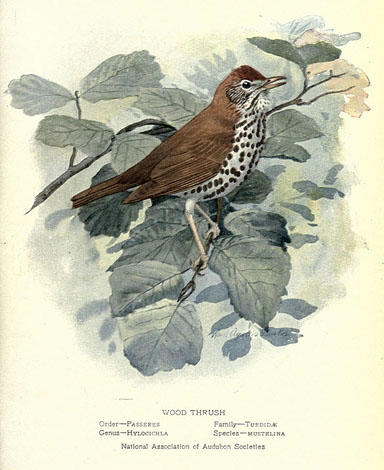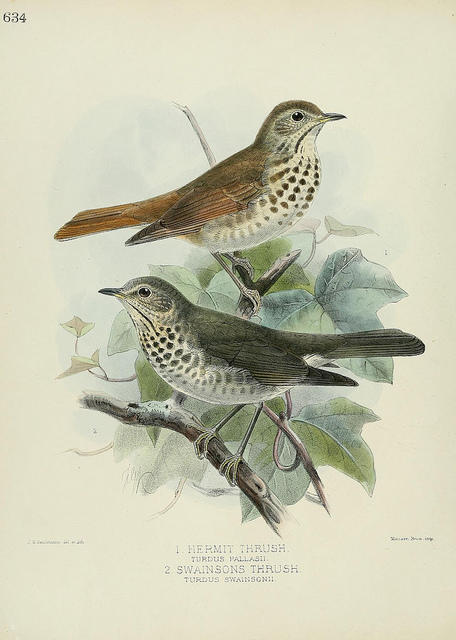This post is part of a series on the collection of ornithologist William Brewster (1851-1919) at the Ernst Mayr Library, written by Elizabeth Meyer, library project assistant.
William Brewster’s summertime journals are filled with birdsong: he noted which species were singing, when, and, to the best of his ability, what those songs sounded like. This left us some beautiful nature writing that also provides some insight on the scientist's emotional connection to his work and study sites. Here are two passages about thrushes (the Turdidae family), which are known for their complex, ringing songs and flute-like voices.
Wood Thrush (Hylocichla mustelina)

Wood Thrush illustration from “Portraits and habits of our birds," v.2. New York city: National Association of Audubon Societies, 1920. See volume on BHL.
As I entered these pines a Wood Thrush was singing and I sat down to listen. Presently he came into a tree nearly over me and then a second bird began singing behind me while a few moments later a third struck up on my right.
I have not heard such a concert from the [Wood] Thrushes for years and, I think, never before in Mass. How they made the woods ring and echo with their solemn chords. The bell-like notes quivered and trembled on the Hill air and showered down from the pine foliage like rain drops when the wind shakes the trees. It was most impressive and thrilled me as deeply as has ever the music of a cathedral choir.” (July 8, 1892. Concord, Massachusetts.) [Edited with line breaks for readability.]
Learn more about Wood Thrushes on the Cornell Lab of Ornithology's "All About Birds" website.
Swainson’s Thrush (Catharus ustulatus)
Illustration of Hermit Thrush and Swainson's Thrush, from 'A history of the birds of Europe'. London: Dresser, 1871-1881. See volume on BHL.
The Swainson's Thrushes sang through the greater part of the day in the rain. One within twenty yards of camp sang during the entire forenoon with only the briefest intervals of silence and apparently in the same place.
There was something peculiarly sad or mournful in the expression of his voice as it came from out the gloomy, water-soaked forest. It moved me strangely and not at all agreeably recalling old associations with these northern forests - associations pleasant enough in themselves but inexpressibly sad as brought back to me by the voice of this Thrush. For an hour or more he interrupted my work and made me utterly wretched.
At the time I supposed that this effect was due to the mood I happened to be in but next day the same bird sang in the same way and with the same effect. The morning & evening singing about our camp has seemed to me delightful and I have looked forward to it through each day.” (June 7, 1896. Lake Umbagog, Maine.) [Edited with line breaks for readability.]
Learn more about Swainson's Thrushes on the Cornell Lab of Ornithology's "All About Birds" website.
- Elizabeth Meyer

